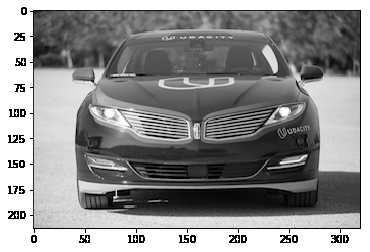卷积神经网络的可视化
Posted alexme
tags:
篇首语:本文由小常识网(cha138.com)小编为大家整理,主要介绍了卷积神经网络的可视化相关的知识,希望对你有一定的参考价值。
卷积神经网络简单可视化
在本次练习中,我们将可视化卷积层 4 个过滤器的输出(即 feature maps)。
加载图像
import cv2
import matplotlib.pyplot as plt
%matplotlib inline
img_path = 'images/udacity_sdc.png'
bgr_img = cv2.imread(img_path)
gray_img = cv2.cvtColor(bgr_img, cv2.COLOR_BGR2GRAY)
gray_img = gray_img.astype("float32")/255
plt.imshow(gray_img, cmap='gray')
plt.show()
定义并可视化过滤器(卷积核)
import numpy as np
filter_vals = np.array([[-1, -1, 1, 1], [-1, -1, 1, 1], [-1, -1, 1, 1], [-1, -1, 1, 1]])
print('Filter shape: ', filter_vals.shape)Filter shape: (4, 4)filter_1 = filter_vals
filter_2 = -filter_1
filter_3 = filter_1.T
filter_4 = -filter_3
filters = np.array([filter_1, filter_2, filter_3, filter_4])
print('Filter 1: \\n', filter_1)Filter 1:
[[-1 -1 1 1]
[-1 -1 1 1]
[-1 -1 1 1]
[-1 -1 1 1]]fig = plt.figure(figsize=(10, 5))
for i in range(4):
ax = fig.add_subplot(1, 4, i+1, xticks=[], yticks=[])
ax.imshow(filters[i], cmap='gray')
ax.set_title('Filter %s' % str(i+1))
width, height = filters[i].shape
for x in range(width):
for y in range(height):
ax.annotate(str(filters[i][x][y]), xy=(y,x),
horizontalalignment='center',
verticalalignment='center',
color='white' if filters[i][x][y]<0 else 'black')
定义一个卷积层
初始化一个包含上面定义的过滤器(卷积核)的卷积层。下面并不是要训练这个卷积神经网络,而是通过过滤器初始化卷积层的权重,从而可以可视化,以看到图片经过一次前向传播后的变化。
import torch
import torch.nn as nn
import torch.nn.functional as F
class Net(nn.Module):
def __init__(self, weight):
super(Net, self).__init__()
k_height, k_width = weight.shape[2:]
self.conv = nn.Conv2d(1, 4, kernel_size=(k_height, k_width), bias=False)
self.conv.weight = torch.nn.Parameter(weight)
def forward(self, x):
conv_x = self.conv(x)
activated_x = F.relu(conv_x)
return conv_x, activated_x
# filters 的大小为 4 4 4
# weight 的大小被增加为 4 1 4 4,1 的维度是针对输入的一个通道
weight = torch.from_numpy(filters).unsqueeze(1).type(torch.FloatTensor)
model = Net(weight)
print(filters.shape)
print(weight.shape)
print(model)(4, 4, 4)
torch.Size([4, 1, 4, 4])
Net(
(conv): Conv2d(1, 4, kernel_size=(4, 4), stride=(1, 1), bias=False)
)可视化每个卷积核的输出
我们首先定义一个函数 viz_layer,以神经网络的一个层和卷积核的数量作为参数。在图像通过这个网络层的时候,这个方法可以可视化这一层的输出。
def viz_layer(layer, n_filters=4):
fig = plt.figure(figsize=(20, 20))
for i in range(n_filters):
ax = fig.add_subplot(1, n_filters, i+1, xticks=[], yticks=[])
ax.imshow(np.squeeze(layer[0,i].data.numpy()), cmap='gray')
ax.set_title('Output %s' % str(i+1))下面观察一层卷积层的输出,观察输出的可视化在 ReLU 激活函数前和激活函数后有什么区别。
plt.imshow(gray_img, cmap='gray')
fig = plt.figure(figsize=(12, 6))
fig.subplots_adjust(left=0, right=1.5, bottom=0.8, top=1, hspace=0.05, wspace=0.05)
for i in range(4):
ax = fig.add_subplot(1, 4, i+1, xticks=[], yticks=[])
ax.imshow(filters[i], cmap='gray')
ax.set_title('Filter %s' % str(i+1))
# 为 gray img 添加 1 个 batch 维度,以及 1 个 channel 维度,并转化为 tensor
gray_img_tensor = torch.from_numpy(gray_img).unsqueeze(0).unsqueeze(1)
print(gray_img.shape)
print(gray_img_tensor.shape)
conv_layer, activated_layer = model(gray_img_tensor)
viz_layer(conv_layer)(213, 320)
torch.Size([1, 1, 213, 320])


# after a ReLu is applied
# visualize the output of an activated conv layer
viz_layer(activated_layer)
以上是关于卷积神经网络的可视化的主要内容,如果未能解决你的问题,请参考以下文章